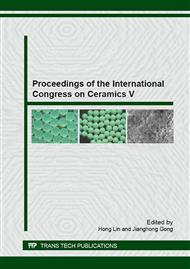p.230
p.234
p.240
p.244
p.249
p.253
p.258
p.263
p.267
In Situ Solidification Formation of the Architectural Ceramics Body with Full Barren Materials
Abstract:
The traditional architectural ceramic body is mainly molded by compression forming process with dry power. The study introduced the starch into the body formula and the feasibility and correlate technological means of the situ solidification forming of fly ash architectural ceramics body with full barren materials were discussed. The body with full barren materials has a low green strength which is less than 1MPa by the traditional compression forming with dry power. But it could be improved greatly by optimizing the kind and amount of starch and the heat holding technologies in the forming process. The research showed that the body’s green strength is higher by introducing modified potato starch. The sintered body’s porosity and water absorption will be increased and lower flexural strength will be obtained by more starch. The body’s properties show the best when the amount of the starch reached 4wt% and the holding time for demoulding is 70min under the holding temperature what is 80°C. Under that molding condition, the green strength reached 3.61MPa, the flexural strength and water absorption of the sintered body reached 49.01MPa and 0.17% separately.
Info:
Periodical:
Pages:
249-252
Citation:
Online since:
July 2015
Authors:
Price:
Сopyright:
© 2015 Trans Tech Publications Ltd. All Rights Reserved
Share:
Citation:


